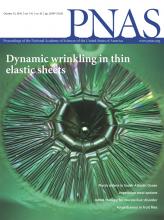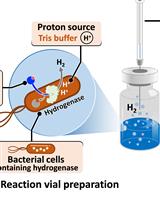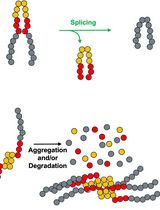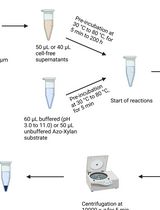- EN - English
- CN - 中文
A Sensitive Coupled Enzyme Assay for Measuring Kinase and ATPase Kinetics Using ADP-Specific Hexokinase
使用ADP特异性己糖激酶测量激酶和ATPase动力学的灵敏耦合酶活测定
发布: 2020年05月05日第10卷第9期 DOI: 10.21769/BioProtoc.3599 浏览次数: 7900
评审: Juan Facundo Rodriguez AyalaKumiko OkazakiJose Antonio Reyes-Darias
Abstract
Kinases and ATPases perform essential biological functions in metabolism and regulation. Activity of these enzymes is commonly measured by coupling ATP consumption to the synthesis of a detectable product. For most assay systems the ATP concentration during the reaction is unknown, compromising the precision of the assay.
Using the ADP-specific hexokinase (ADP-HK) from the thermophilic archaeon Thermococcus litoralis the protocol outlined here allows real time coupling of ATP consumption to downstream signal change enabling accurate kinetic measurements. ADP-HK phosphorylates glucose that is then used by glucose-6-phosphate dehydrogenase to reduce NAD+ to NADH which can be measured at 340 nm. We have shown this assay to be sensitive to the detection of micromole quantities of ADP with no detectable background from ATP.
Background
Kinases and ATPases can be measured by coupling the production of ADP to a spectrophotometrically detectable signal. Commercial vendors provide kits that detect the amount of ADP produced or ATP depleted by coupling them to the production of a fluorescent or bioluminescent signal (examples include ATP-Glo; Promega, ADP-sensor; Biovision). These kits are sensitive but are hard to apply to kinetic questions because they are end-point assays, measuring ADP amounts at a single time point. Furthermore, the black box nature of such kits make it difficult to determine if reaction mixtures are in the steady-state conditions required for Michaelis-Menten kinetics.
Continuous assays measure enzyme activity over time allowing the determination of enzyme rate in a single run. The classic continuous coupled-enzyme assay is the pyruvate kinase and lactate dehydrogenase system (Kornberg and Pricer, 1951). During the reaction, pyruvate kinase uses the ADP produced by the target enzyme to convert phosphoenolpyruvate to pyruvate and in the process regenerate ATP. Pyruvate is then used by lactate dehydrogenase to oxidize NADH to NAD+ which is measured by the decrease of absorbance at 340 nm (Figure 1A). A drawback of this method is that in regenerating the ATP continuously, the ATP concentration at any given point is unknown which means that Michaelis-Menten kinetics for ATP cannot be calculated.
An optimal coupled reaction proceeds in a linear pathway so that the ADP produced is converted stoichiometrically into the component producing the signal. ADP-specific hexokinase (ADP-HK) from Thermococcus litoralis uses ADP to phosphorylate glucose into glucose-6-phosphate, which can be used by glucose-6-phosphate dehydrogenase (G6PDH) to reduce NAD+ to NADH (Ito et al., 2001; Sakuraba and Ohshima, 2002) (Figure 1B). ADP-HK is an ADP-specific enzyme from thermophilic archaea that is adapted to consume ADP instead of ATP, probably because of the higher thermostability of ADP over ATP. ADP-HK has previously been used in conjunction with G6PDH and diaphorase I to measure the abundance of dNDPs from cellular extracts with a colorimetric signal but has yet to be demonstrated in a continuous assay to measure kinetics (Kumagai et al., 2014). Here, we have used the specificity of ADP-specific hexokinase to develop a method for assaying ADP production by kinases and ATPases.

Figure 1. Schematic of two coupled enzyme assays to measure ATPase/kinase activity. A. The traditional method for measuring ATPase/kinase activity uses pyruvate kinase to couple ADP production to the conversation of phosphoenolpyruvate (PEP) to pyruvate and then lactate dehydrogenase (LDH) to convert pyruvate to lactate–which simultaneously oxidizes NADH to NAD+ resulting in a decrease of absorbance at 340 nm. B. Our alternative method uses ADP-HK to couple ADP production to the phosphorylation of glucose which is then used by glucose-6-phosphate dehydrogenase (G6PDH) to convert glucose-6-phosphate to gluconate-6-phosphate–which simultaneously reduces NAD+ to NADH resulting in an increase of absorbance at 340 nm.
Materials and Reagents
- Proteosec 6-600 column (Generon)
- Thermococcocus litoralis gDNA (Deutsche Sammlung von Mikroorganismen und Zellkulturen, Strain number: DSM-5473)
- pRSET-A expression plasmid (Thermo Fisher)
- Competent E. coli KRX (Promega)
- ADP-HK expressed and purified from E. coli, stored at -80 °C
- G6PDH from baker's yeast (Sigma-Aldrich, catalog number: G6378-100UN ), stored at 4 °C
- D-Glucose, powder stored at room (Sigma-Aldrich, catalog number: G8270-100G ), stored as powder at room temperature
- NAD+ (Sigma-Aldrich, catalog number: N1636-25MG ), stored in aliquots of 50 mM reaction buffer (see Recipes) at -80 °C
- ADP (Sigma-Aldrich, catalog number: A2754-100MG ), stored in aliquots of 100 mM reaction buffer (see Recipes) at -80 °C
- ATP (Sigma-Aldrich, catalog number: A2383-1G ), stored in aliquots of 100 mM in reaction buffer (see Recipes) at -80 °C
- Tris Base (Melford, catalog number: T60040-5000 )
- NaCl (Sigma-Aldrich, catalog number: S9888-1KG )
- MgCl2 (Sigma-Aldrich, catalog number: 208337-1KG )
- Terrific Broth (Melford, catalogue number: 7758-11-4 )
- Rhamnose (Melford, catalogue number: 10030-85-0 )
- Ni-NTA resin (Generon NB-45-00042-100)
- Imidazole (Sigma-Aldrich, catalogue number: I5513-100G )
- BCA (bicinchoninic acid) (Thermo Fisher, catalogue number: 23225 )
- Reaction buffer (see Recipes)
- ATPase/kinase (see Recipes)
- 1,000 Units/ml G6PDH (see Recipes)
- 50 mM NAD+ (see Recipes)
- 100 mM ADP (see Recipes)
- 100 mM ATP (see Recipes)
- 1 M Glucose (see Recipes)
- 2x Assay reagent (see Recipes)
Equipment
- UV spectrophotometer (Shimadzu, model: UV-1601 )
- 100 µl quartz microcuvette (Hellma, model: 105-201-15-40 )
- Ti 45 Fixed-Angle Titanium Rotor (Beckman Couler, model: Ti 45 )
- Centrifuge (Beckman Couler, model: Allegra® J2-21)
- Äkta Purifier (GE Healthcare)
- -80 °C freezer
Software
- Graphing software (e.g., Origin Pro, OriginLab)
Procedure
文章信息
版权信息
© 2020 The Authors; exclusive licensee Bio-protocol LLC.
如何引用
McFarlane, C. R. and Murray, J. W. (2020). A Sensitive Coupled Enzyme Assay for Measuring Kinase and ATPase Kinetics Using ADP-Specific Hexokinase. Bio-protocol 10(9): e3599. DOI: 10.21769/BioProtoc.3599.
分类
微生物学 > 微生物生物化学 > 蛋白质 > 活性
细胞生物学 > 基于细胞的分析方法 > 酶学测定
生物化学 > 蛋白质 > 活性
您对这篇实验方法有问题吗?
在此处发布您的问题,我们将邀请本文作者来回答。同时,我们会将您的问题发布到Bio-protocol Exchange,以便寻求社区成员的帮助。
Share
Bluesky
X
Copy link













